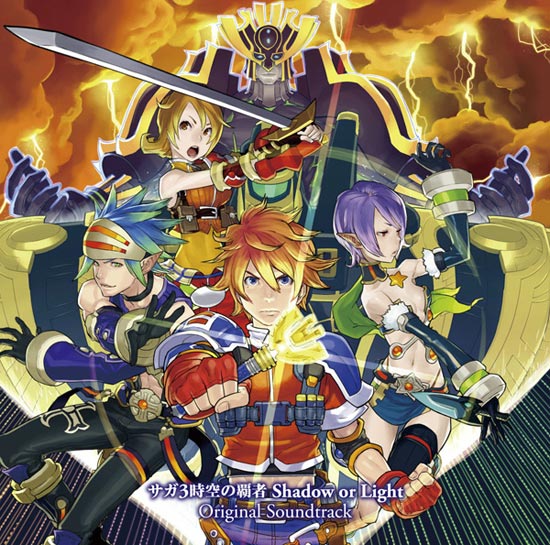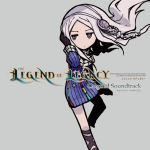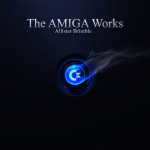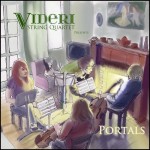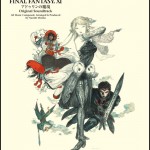It was some time ago that we reviewed the SaGa 2: Goddess of Destiny remake soundtrack. If you recall, it was released around the same time as the enormous SaGa Premium Box, making it somewhat redundant with just a modest increase in sound quality and a single arrangement by artist muZik. For that reason, when the SaGa 3 remake soundtrack was announced, I didn’t think much of it.
However, when I learned that Ryuji Sasai was personally on board to work on arrangements of his music, including an additional bonus track the end, I changed my tune. Sasai is joined by Kenji Ito to arrange the entire soundtrack from SaGa 3 on the Game Boy, and there are even more surprises within.
Hit the jump to find out if the SaGa 3 remake soundtrack is actually worth your time and money.
So, those other surprises are actually entirely new tracks. I guess with this remake, they needed more music than the original game featured, so Sasai and Ito each composed a few new pieces for the game.
To get some housekeeping out of the way, Chihiro Fujioka does not appear on this album, and for the most part, Kenji Ito arranges his tracks. Interestingly, Ito also arranges some of Sasai’s tracks, which is odd given Sasai’s direct involvement, but it works for the most part.
In terms of what you’re actually going to hear, think of early PlayStation era soundtracks like Beyond the Beyond (which I was often reminded of on several occasions). Sasai not only rocks, but applies a gentle hand to some of the town and ending themes, while Ito is all over the place with his arrangements.
Let’s start with Kenji Ito. The album opens with one of his new compositions: a bright, triumphant, and energetic piece that works in subtle references to the familiar series theme. Ito next has the opportunity to arrange the series theme, “Opening,” adding rhythmic percussion to give the track an exotic flair, which seems to be his style of choice lately.
Ito does a stellar job throughout, turning a battle theme that never struck me as a battle theme (“Gods of Another Dimension”) into something that The Black Mages would perform, and adding a playful twist to “Oasis” with pizzicato strings and toy percussion. He turns Sasai’s originally minimalistic “Dungeon” into a fleshed out piece with layered synths, pads, and lots of vibrato to add a dark and otherworldly quality, and in one of his most impressive efforts, reimagines Fujioka’s “Deep” into a highly memorable and funky track with electronic percussion and a dreamy woodwind melody. Finally, another of his original tracks, “Hold Out,” will prepare you for battle with its dominating slap bass.
It’s then on to Sasai. I have to admit that what he offers here is a bit of a mixed bag, but let me start with what he does well. He opens with “Fight!,” which is a high-speed shred fest that you’d expect from this rocker turned game composer. Due to the limitations of the Game Boy, I never felt that this track had enough speed or energy to be a great battle theme, but this is rectified here, continuing right into an explosive rendition of “Eat the meat.” One of my favorite tracks on the album is “Warrior’s Rest,” which was originally composed by Fujiokai. It’s a very melancholy piece with a melody that’s reminiscent of “Hotel California” by the Eagles, and Sasai’s choice of somber belltones and an acoustic guitar only make that influence more apparent. Sasai is right at home with the powerful rock tracks that come in towards the end of the album, with the desperate string melody in “Steslos” and the galloping percussion, orchestral hits, and string melody in “Laguna’s Palace” that bring back memories of his popular “Last Castle” theme from Final Fantasy Mystic Quest.
Not all of the tracks receive such an impressive makeover, however. Some of the arrangements don’t do the original compositions much justice, losing much of their original charm in the transition. One such track is Sasai’s “Setting Off Into the Future,” which swung along deliberately on the Game Boy, but doesn’t manage to stand out here. That’s the problem with many of Sasai’s contributions: they simply don’t stand out. To give another example, the original “Holy Ruins” was a case where less was more, and the addition of extra instruments in the arrangement here dilutes out the key elements, making it much less effective.
Oh, but there is a bonus track tucked away at the end of the album. Titled “Opening Arrange,” it’s Sasai’s take on the theme with live electric guitar work and possibly other instruments (there are no credits listed for this track). The percussion, bass, and guitar work all sound amazing, although the synth quality is questionable. Still, the guitar work is excellent, and this is a pretty substantial bonus at 3:40 in length, allowing for some interpretation by Sasai. This track makes me wish that Sasai had been given the freedom to work with a higher quality sound library, as this track indicates that it would have made a huge difference.
There’s not much here in terms of packaging. Credits with a composer and arranger breakdown, some character artwork (there’s a character named Milfie in this game?), and a brief listing of the development staff. I dig the colorful cover artwork, and the disc itself is silver with a red washed out print of the game’s characters, which looks pretty cool.
While I have to say that I enjoyed this album much more than the SaGa 2 remake soundtrack, it still has some flaws. While it offers a large increase in sound quality if you consider the Game Boy to the PlayStation, we’ve still come a long way since even then, and it would have been nice to have seen some bigger sounds. Additionally, not all the compositions carry over well, which unfortunately is hard to control. Still, the album is out today in Japan (January 12, 2011), and I recommend checking it out if you’re a fan of the game, Ryuji Sasai, or rock music. It’s available at CD Japan for about 2,500 Yen.
What do you think of the SaGa remake soundtracks and the difficulty with carrying over every piece of music and trying to make it work? Are you surprised to see Ryuji Sasai directly involved after so many years away from the videogame industry?
Tags: Arrangements, Kenji Ito, Music Reviews, Reviews, Ryuji Sasai, SaGa, SaGa 3, Square Enix, Videogame





























